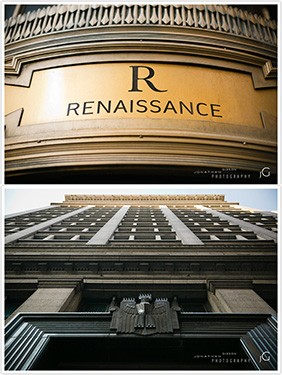
Communiversity Class Focuses on Preservation Triumphs in the Queen City
Burnham is nationally-known for skyscrapers in New York City, Chicago and Washington D.C. He was the architect for the Worlds Fair in Chicago in 1893 and designed the Flatiron Building in New York City. Between 1901 and 1905, Burnham also designed four of Cincinnatis spires between East 4th and 5th Streets.
In 1901, Burnham built the Union Savings Bank and Trust at the corner of Fourth and Walnut. The bank was Cincinnatis first skyscraper and is now the Renaissance Hotel. What an appropriate name for the restored Burnham work adding to the Renaissance of Downtown Cincinnati! This hotel is listed on the National Register of Historic Places.
During this class, Frank Farmer Loomis, a
n accomplished writer and
media personality, will take you on a tour of this historic treasure. You will examine Burnhams architectural style and distinctive ornamental detail up close. Class will get a tour of the original Bank Director's office overlooking the Hotel Ballroom, which was the bank lobby. Then, we will have lunch at D. Burnhams
restaurant on the 1st floor of the hotel and witness this historic preservation triumph!
Class will be held on Saturday, May 20. Register online at uc.edu/commu or call 513-556-6932. Don't miss out on this unique opportunity to celebrate all the preservation triumphs in our city!
Related Stories
University of Cincinnati celebrates DAAP's class of 2024:...
April 27, 2024
Discover the achievements of the University of Cincinnati's College of Design, Architecture, Art, and Planning's Class of 2024 as they graduate into the alumni family, showcasing exceptional talent and innovation. From prestigious awards to prominent job offers, these graduates exemplify the transformative power of creativity and dedication in shaping tomorrow's leaders.
Ancient Maya blessed their ballcourts
April 26, 2024
Using environmental DNA analysis, researchers identified a collection of plants used in ceremonial rituals in the ancient Maya city of Yaxnohcah. The plants, known for their religious associations and medicinal properties, were discovered beneath a plaza floor upon which a ballcourt was built, suggesting the building might have been blessed or consecrated during construction.
UC celebrates record graduating class at commencement
April 26, 2024
UC celebrated its doctoral hooding and master's recognition ceremony at Fifth Third Arena as part of its three-day commencement for the largest graduating class in university history.
